August 9, 2013
Air Date: August 9, 2013
FULL SHOW
SEGMENTS
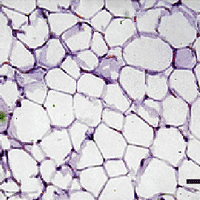
Chemicals That Promote Obesity Down the Generations
View the page for this story
Diet and exercise are seen as the key factors that cause obesity, but new research suggests that certain chemicals called obesogens contribute to the global weight problem. Bruce Blumberg, professor of developmental and cell biology at the University of California at Irvine tells host Steve Curwood that the effects of an obesogenic chemical he studied seem to persist for several generations. (07:25)

Secret Cash for Climate Denial
View the page for this story
There's broad scientific consensus that climate disruption is human-induced, yet global warming is still hotly debated. Suzanne Goldenberg joins host Steve Curwood to discuss her recent article in the UK newspaper The Guardian. It investigated the anonymously funded Donor’s Trust and Donor’s Capital Fund which together have given over $100 million dollars to climate change denial groups in the United States over the past decade. (06:40)
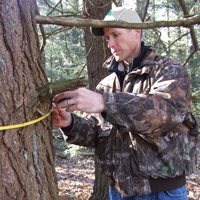
Working Woodlands for Carbon and Cash
/ Ann MurrayView the page for this story
Nearly three-quarters of Pennsylvania's woodlands are still in private hands. As Ann Murray reports, the Nature Conservancy has helped develop a program to persuade land-owners to preserve forests by rewarding them for the carbon the trees sequester. (05:35)

How Insects Influence Plant Evolution
View the page for this story
From the spiciness of the chili pepper to horseradish’s bitter bite, many plant traits are evolutionary adaptations to insect attacks. Cornell biologist Anurag Agrawal explains to host Steve Curwood just how speedily plants can evolve and adapt when insect populations change. (07:15)

Snow in Summer
/ Mark Seth LenderView the page for this story
Salt Marsh Diary’s Mark Seth Lender observes the brilliant white of the Snowy Egret does little to camouflage the bird, nor does it explain how the egret will survive the changing climate. (02:20)
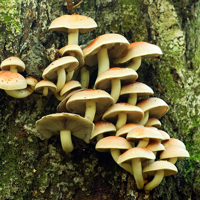
Fungi
/ Ari Daniel ShapiroView the page for this story
There's much more to fungi than the familiar mushrooms and toadstools. As Ari Daniel Shapiro reports, fungi are both the great creators and the great destroyers of the plant kingdom. (05:30)

Sounds Heard by Aldo Leopold
View the page for this story
Each morning, the conservationist Aldo Leopold took meticulous notes of the dawn bird chorus at his Wisconsin cabin. Now, a team from the University of Wisconsin have used Leopold’s journals to recreate the soundscape that Leopold heard in 1940. Professor Stanley Temple talks about the project and Leopold’s influence on the environmental movement. (12:40)
Show Credits and Funders
Show Transcript
Host: Steve Curwood
Guests: Bruce Blumberg, Suzanne Goldenberg, Anurag Agrawal, Stanley Temple
Reporters: Ann Murray, Mark Seth Lender, Ari Daniel Shapiro
[THEME]
CURWOOD: From Public Radio International, this is Living on Earth.
[THEME]
CURWOOD: I'm Steve Curwood. New research on chemicals widely used in the environment shows they make lab mice and their offspring fatter
BLUMBERG: So what we found is that the effects persisted in the grandchildren and the greatgrandchildren and that some of the effects were actually stronger in the greatgrandchildren who had never been exposed. 44 some of the so-called fat depots were twice as big; overall the animals were probably about 15% fatter.
CURWOOD: Also, the secret life of fungi:
BODDY: Most of us think of fungi as things like mushrooms and toadstools. But that's just the tip of the iceberg. There's another part of the fungus - it's usually hidden in rotten wood and in the leaf litter on the forest floor.
CURWOOD: The fungus among us and its vital role in the ecosystem - We’ll have those stories and more this week, on Living on Earth. Stick Around!
[NEWSBREAK MUSIC: Boards Of Canada “Zoetrope” from “In A Beautiful Place Out In The Country” (Warp Records 2000)]
ANNOUNCER: Funding for Living on Earth comes from Stonyfield Farm, makers of organic smoothies, yogurt and more.
Chemicals That Promote Obesity Down the Generations
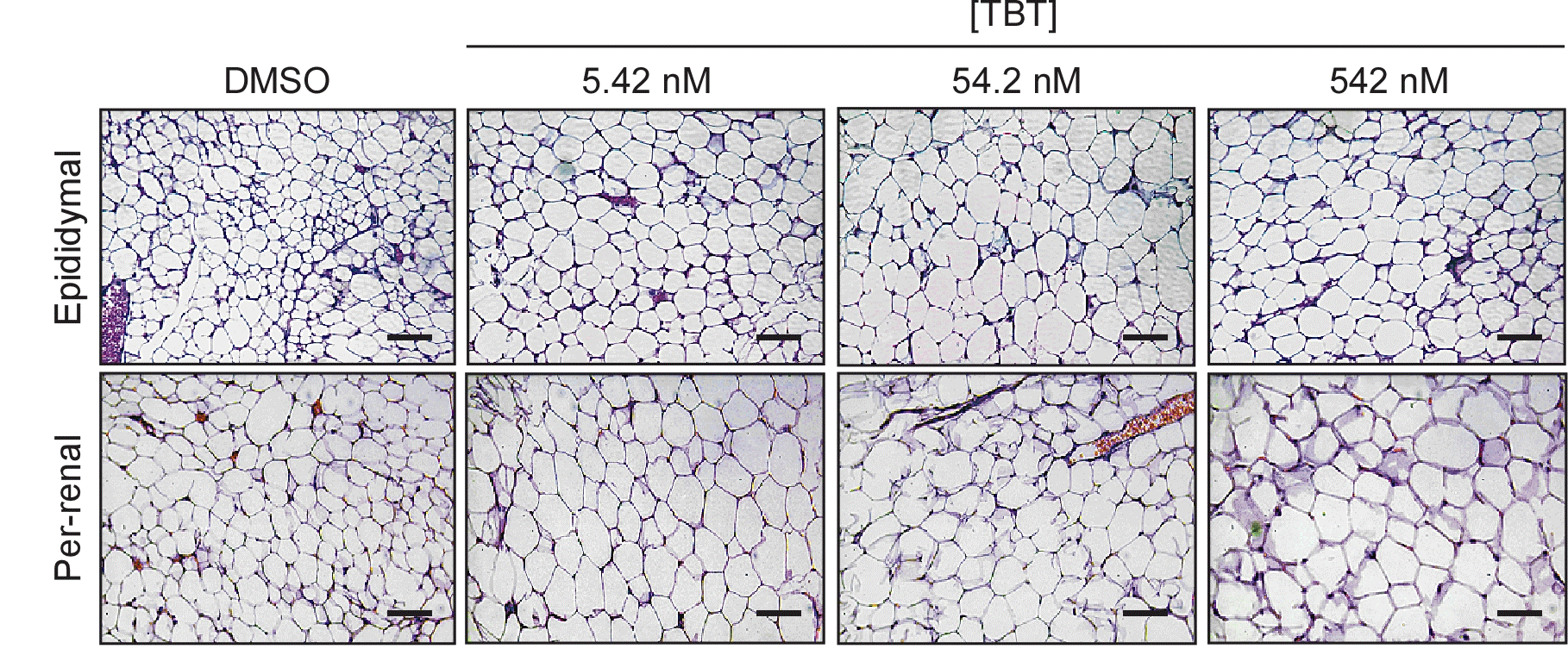
A TBT-linked fat cell (photo: Bruce Blumberg)
CURWOOD: From the Jennifer and Ted Stanley Studios in Boston, this is a recycled edition of Living on Earth. I'm Steve Curwood. Conventional wisdom says over-eating and the lack of exercise are behind the obesity epidemic in America and much of the world. But that’s not the whole story, according to some research from the University of California, Irvine that implicates certain chemicals called "obesogens". Here's Professor Bruce Blumberg.
BLUMBERG: An obesogen, according to us, is a chemical that somehow causes the body to store more fat. And it can do that by making more fat cells, by putting more fat into those cells, or can do that indirectly by changing how the metabolism works or by making you hungrier, or by making you less able to sense that you’ve had enough to eat.
CURWOOD: Bruce Blumberg is a professor of Developmental Biology at UC Irvine. And here’s the startling part of his research. Not only has his team confirmed earlier work showing that certain persistent organic pollutants can act as obesegens, they have found that initial exposures can echo down through at least three generations to make animals fat. This study used the chemical TBT – tributyltin --which was widely used as anti-fouling paint until a few years ago.
BLUMBERG: So we exposed pregnant mice to very low doses of tributyltin, and we knew from our previous work that would give us an effect on the babies that were so exposed - that would be - we would call that the F-1 generation. And we asked the question what happens if we bred those babies and the babies of those babies and checked whether there were subsequent effects.
CURWOOD: And what happened?
BLUMBERG: So what we found is that the effects persisted in the grandchildren and greatgrandchildren. And that some of the effects were actually stronger in the greatgrandchildren who had never been exposed.
CURWOOD: So how much fatter were these animals compared to your controls?
BLUMBERG: It depends on which part of fat we looked at. So the effect on fat on different parts of the body was different, but some of the so-called fat depots were twice as big. Overall, the animals were probably about 15 percent fatter.
CURWOOD: Now this study is lab mice, how well do you think these findings might translate to humans?
BLUMBERG: 100 percent.
CURWOOD: Really?
BLUMBERG: The reason I say that is because tributyltin - TBT - works through a hormone receptor called PPAR gamma. And we know there are pharmaceutical drugs that target that same receptor that make people fat. So if I have a chemical tributyltin that activates the same receptor, you would expect the same effect.
CURWOOD: So walk me through the actual physiological process of how a chemical like tributyltin works to become an obesogen.
BLUMBERG: So as much as we know about tributyltin, it activates this hormone receptor PPAR gamma, and PPAR gamma works as a...it has a partner. So it works as a dimer. It has two parts. And the other part of that is called RXR, retinoic X receptor. So if TBT happens to get into a stem cell, and PPAR RXR gamma is there, it activates that complex, and it turns on a set of genes that cause the cell to become a fat cell. And along with that comes the ability to store lipids, to store fats. If PPAR gamma is not there, that stem cell will become a bone cell.
CURWOOD: One of the most startling things that’s in your report is your citation of a study that showed eight different species of animals including pets, laboratory animals, and feral rats, living in proximity to humans have become obese in parallel with the human obesity epidemic. And the odds of this being a coincidence was something like 10 million to 1 against.

Dr. Bruce Blumberg (photo: Bruce Blumberg)
BLUMBERG: 10 million to 1. Yes.
CURWOOD: So what does that mean in your eyes about the human obesity epidemic?
BLUMBERG: You can make the argument, if you talk to...the mainstream obesity community will make the argument that it’s all about diet and exercise, calories in and calories out. And I don’t see how you can explain the increase in obesity of animals, including wild animals, by calories in and calories out. It’s got to be something else. It has to be the nature of the calories. It has to be a chemical, an environmental factor, to which they’re exposed to now, that they were not previously exposed to, that underlies that.
CURWOOD: So who’s most susceptible to tributyltin exposure?
BLUMBERG: Tributyltin will make animals and humans fat at any stage of life. We’re particularly concerned with prenatal exposures because that’s where you have the capability to have transgenerational effects. You won’t cause, or we don’t believe that you will...exposing an adult will cause transgenerational effects on their offspring. But we know from our experiments, that exposing embryos to a chemical like tributyltin will cause transgenerational effects.
CURWOOD: So Professor Blumberg, tell me - that I might need a couple notches on my belt - maybe I could blame on my mother or grandmother?
BLUMBERG: I don’t know if you could blame it on them. What your mother or grandmother was exposed to will affect the efficiency with which you handle calories. It’s well known that obese people have more efficient metabolisms. They store a higher proportion of the calories that they eat. Obviously, they do eat more, but they also store more of every calorie that they eat as fat, compared to non-obese people, so that’s an example of what we call metabolic programming.
CURWOOD: So what does that say now thinking of our social policy in dealing with human health and obesity?
BLUMBERG: It says to me that the most important way that we can change obesity is not by treating obese people, but by preventing them from becoming obese in the first place, by preventing these exposures, which can include chemical exposures, but it can also include exposures to improper diet. There’s a fair bit of data that says exposing mom to a high fat or junk food diet makes the babies prefer that kind of food. There’s some kind of a programming event that’s not well understood that’s going on there. So it’s not just chemical exposures. Chemical exposures and dietary factors, and the nature of diet early in life, is the area that needs to be addressed to make inroads into solving this obesity problem that we face today.
CURWOOD: And what about the folks who are already chubby?
BLUMBERG: Well, it doesn’t mean that we shouldn’t help them, but I think that we’re better off preventing them from becoming chubby. You know, there’s a lot of data out there that suggests that 90 percent of people who lose even a significant amount of weight will gain it back. That’s also a very important factor here. Imagine you’re a person who has worked very hard; you’ve dieted hard; you’ve exercised hard; you’ve lost 150 pounds. You look and feel better than you ever have in your life. Why is it a 90 percent probability that you gain that weight back?
CURWOOD: And the answer is?
BLUMBERG: The answer is to me that it’s not strictly behavior. It’s a metabolic programming, that your body is programmed to behave in a certain way, by your early life experiences, and that it’s very difficult to fight that.
CURWOOD: Dr. Bruce Blumberg is a professor of developmental and cell biology at the University of California Irvine. Thank you very much professor.
BLUMBERG: You’re welcome. It was a pleasure.
Related links:
- Professor Blumberg’s paper in Environmental Health Perspectives 1.15.2013: Transgenerational Inheritance of Increased Fat Depot Size, Stem Cell Reprogramming, and Hepatic Steatosis Elicited by Prenatal Obesogen Tributyltin in Mice
- More about Prof. Bruce Blumberg
[MUSIC: Louis Armstrong “All That Meat And No Potatoes”” from Satch Plays Fats (Columbia Records 1955) (Happy belated Birthday to Satchmo 8/4/1901 – 6/6/1971)]
Secret Cash for Climate Denial
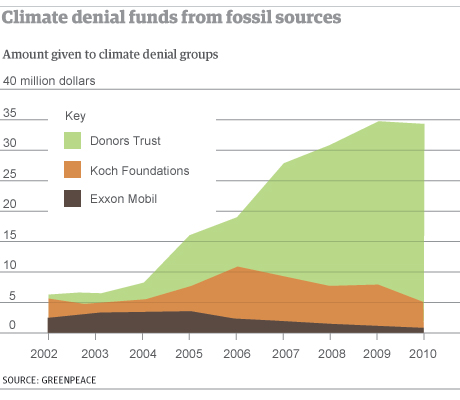
Graph of funding for climate denial from The Guardian (image: The Guardian)
CURWOOD: The 2012 US presidential election was the most expensive in history, and much of the six billion dollars spent came from undisclosed donors. There's no question that secret money is powerful and influential in American public life -- and not just on electoral races. A recent investigation by the UK newspaper The Guardian revealed that over the past decade a pair of anonymous donor funds gave over $100 million dollars to US groups that deny a human role in climate change. Suzanne Goldenberg, the US environment correspondent for The Guardian conducted the probe, and she joins us now.
GOLDENBERG: Donors Trust and Donor's Capital Fund are two vehicles which were put together for the express purpose of channeling donations from conservative donors to conservative groups. They have tax advantages for wealthy donors, but the other thing they offer their clients is an assurance the money won't be diverted to liberal causes, and complete anonymity. So they don't have to become known as the benefactors of these causes.
CURWOOD: How much money we talking about here?
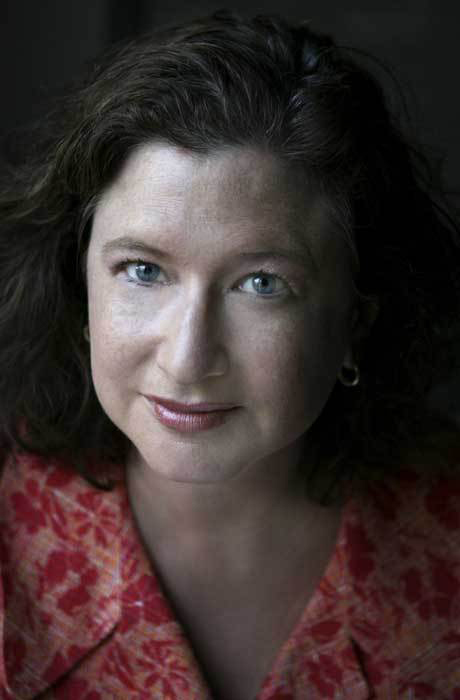
Suzanne Goldenberg (Photo: Suzanne Goldenberg)
GOLDENBERG: Over the last 10 years or so they've raised about $400 million dollars, of which about a quarter, a little more than $100 million dollars has gone to about 100 different organizations that have worked to undermine the science behind climate change, or have worked to block action on climate change.
CURWOOD: Now, how does this work in US law if these are a tax-exempt organizations, one would think they would have to reveal their donors.
GOLDENBERG: No, these are perfectly legal. As conservatives point out there's an equivalent on the liberal side of the political spectrum called the Tides Foundations. These things are perfectly legal, and what they do is they enable people to give money to a sort of black box, if you like, a council of advisors who will then distribute the money to other causes. So you can see the money going out to those causes, but you can't see the money going in.
CURWOOD: Suzanne, who are the groups who are getting these funds?
GOLDENBERG: You're talking about a range of groups here. You're talking about think tanks, organizations like the Heartland Institute in Chicago which over the years has organized annual conferences which are kind of an alternative to the UN climate conference where gather scientists and academics who do not accept established science on climate change. You’ve had other organizations which have focused on bringing lawsuits against climate scientists. One of the group they support is called Committee for a Constructive Tomorrow, One of its main causes is to put out a website called Climate Depot, which is a clearinghouse of information that attacks the science behind climate change and attacks people trying to bring about action on climate change. It’s published, for example, the phone numbers of climate scientists and the e-mail address of climate scientists and encouraged people to write angry e-mails to these people. So it’s a range of organizations that are supported by Donor’s Capital Fund and the Donor’s Trust.
CURWOOD: So let’s step back for a moment. This is a dark pool. We don't know where this money is coming from. But the folks who stand to perhaps lose the most if this country takes on the challenge of climate are those who are in the fossil fuel industry.
GOLDENBERG: That's true, I mean, economically, but I don't think you can say that this is just about the money I mean, the more I’ve studied these groups - and I’ve studied for long time - I think you cannot ignore the importance of ideology here. A lot of wealthy conservatives who are opposed to action on climate change, not because all their money is wrapped up an oil companies, but because they really are opposed any kind of government intervention in the economy. And they are afraid that if you start to put limits on carbon emissions and that's the sort of first step towards lots of government intervention in the economy, and then next thing you know we’ve got a global government and a single global currency.
CURWOOD: Conservatives aren’t the only ones that use anonymous donor mechanisms; liberals do as well. What's, what's the problem here?
GOLDENBERG: To me that the main difference is the causes they’re supporting. When you're talking about science - when you're talking about the facts of climate science - the two sides aren't equivalent. And I don't think that it's legitimate to say putting out information about science is one thing and putting out information that is factually wrong is just as valid. Because they clearly aren’t. I think as a society we’d be concerned if organizations were taking secret money to go out and say, hey, smoke as many cigarettes as you like, it won't hurt you; hey, be afraid when you use a public washroom, you can get HIV aids from toilet seats. I think it's a very different thing when you're talking about putting out information that is factually incorrect, and you're doing that in a secretive fashion.
CURWOOD: So how are these groups involved in the public discussion on climate? I'm thinking of President Obama recently saying in his State of Union as well as his inaugural address, that he wanted to be more active on that. Donor’s Trust supported organizations in response to that?
GOLDENBERG: They jumped right on it. It was really interesting to see. You know, the folks at Climate Depot put out a point by point rebuttal of the things that Obama was discussing in his State of the Union address. And since then, it’s also interesting to see Climate Depot have really gone on the attack against the protestors of the Keystone Pipeline project.
CURWOOD: Suzanne Goldenberg, you’ve been looking at this now for more than a year. What effect do you think that the Donor’s Trust and the Donor’s Capital Fund has had on the climate conversation in this country over the past few years?
GOLDENBERG: I think they’ve created a lot of confusion, and a lot of controversy about an area that used to be seen as apolitical, and with the solutions used to be seen as clear-cut. So they have made it virtually impossible for the White House or for the Congress to act on climate change because this area is now seen as so...you know it's a political third rail, if you like. And they have scared the politicians away from taking on a big challenge.
CURWOOD: Suzanne Goldenberg, is the US environment correspondent for the UK paper, The Guardian. Thank you so much Suzanne.
GOLDENBERG: Thank you.
CURWOOD: We asked Donor's Trust for comment. An email from CEO Whitney Ball is on our website, loe.org, and it reads, in part, "Donor’s Trust was established to promote liberty and to help like-minded donors preserve their charitable intent. As donor-advised funds are not required to disclose their donors,” she wrote that “comments in the press that label the Trust as ‘secretive’ and refer to its ‘dark money’ are ‘unfair and misleading’.”
Related links:
- Original Guardian article
- Suzanne Goldenberg’s staff page
- Donor’s Trust webpage
[MUSIC: Traffic “Glad” from John Barlycorn Must Die (Island Records 1970)
CURWOOD: Coming up what we - all of us - owe to plants. That's next on Living on Earth.
[CUTAWAY MUSIC: Davell Crawford: “Hallelujiah, I Love Her So” from The B-3 And Me (Bullseye Blues 1998)]
Working Woodlands for Carbon and Cash
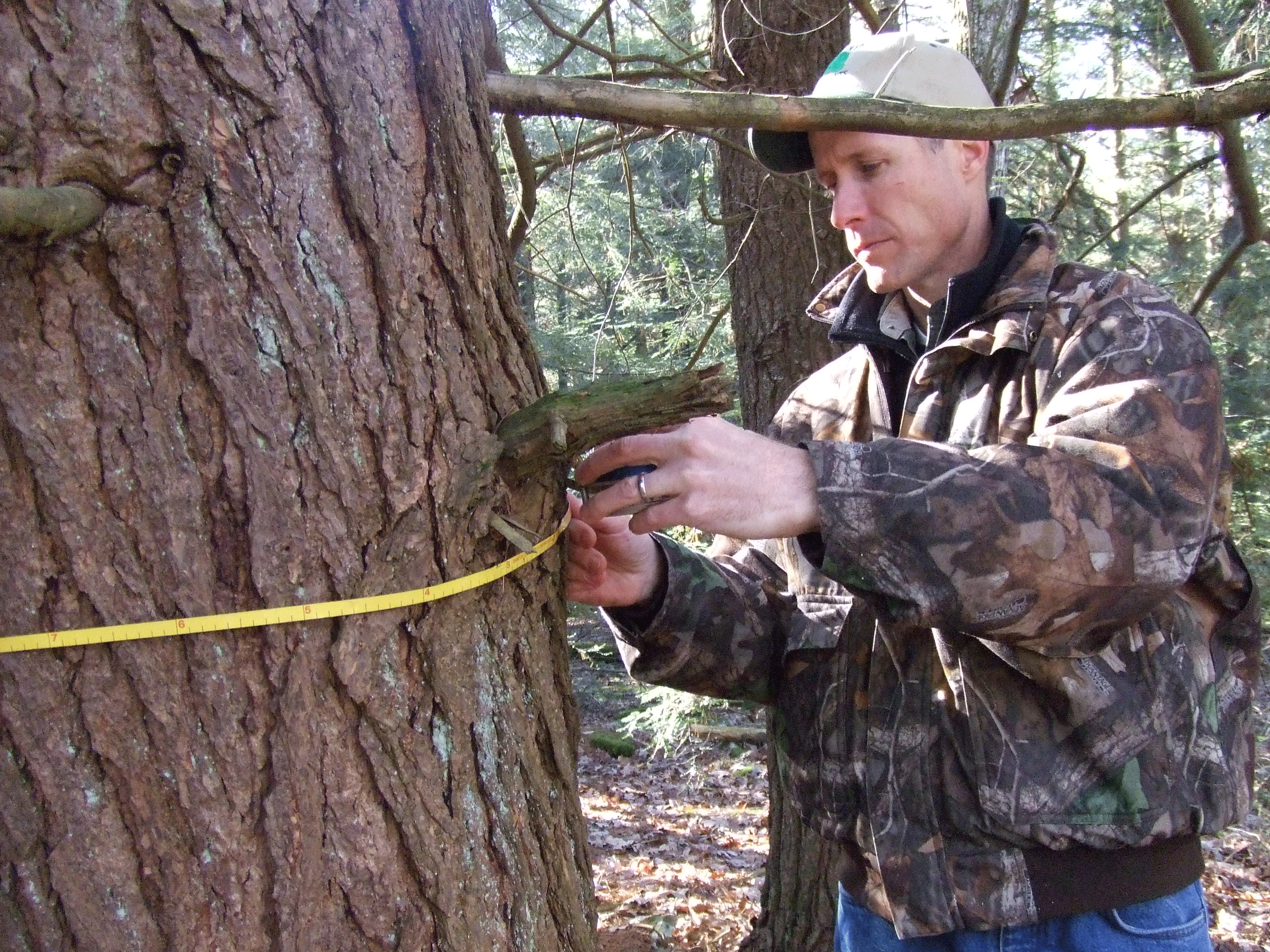
The Nature Conservancy's Mike Eckley uses a prism to identify trees to include in an inventory of the Lock Haven forest. 1000's of small plots will be documented in the 22,000 acre forest. (Photo: Ann Murray)
CURWOOD: It’s Living on Earth, I'm Steve Curwood. When it comes to fighting climate disruption, trees are some of the most effective front line soldiers. An acre of healthy forest can pull as much as 3 or more tons of carbon out of the air each year, and the bigger the tree the more carbon it can store or sequester in its trunk. The state named after founder William Penn’s woods---Pennsylvania—has plenty of forests, about 70 percent in private hands. These woods are the subject of a value-added program developed by the Nature Conservancy that is designed make money for forest owners while still sequestering carbon and keeping the air and water clean.
The Allegheny Front’s Ann Murray has our story .
MURRAY: A Pennsylvania forest has a new, surprising ally. You might even call it a sponsor.
[COMMERCIAL: Meet the Chevy Equinox. And meet a world of new experiences, new places...]
MURRAY: Chevy Equinox is not just a smallish SUV the auto giant is marketing to the young and hip, it’s also paying to keep a forest a forest. Bethlehem, Pennsylvania Water Authority gets paid by Chevrolet for each ton of CO2 that the trees in its 22,000 acre forest pull out of the air and store in their trunks and roots. That’s according to Steve Repach, the authority’s director.
REPACH: We’re anticipating, to be on the safe side, anywhere between $75,000 to $100,000 annually. If we get more than that… great.
MURRAY: Bethlehem is the first partner in The Nature Conservancy’s Working Woodlands program. A model project that the Conservancy has put together with Blue Source, a carbon credit developer in California.
Working Woodlands is one example of what you might call value-added forestry. That is, a way to keep forests healthy while also making money off them.
WILLIAMS: For the landowner they get kind of a one-two punch.
MURRAY: Roger Williams is the president of Blue Source, the carbon brokerage.
WILLIAMS: Several years ago, we began conversations with the Nature Conservancy and the intent was to combine FSC forest certification with the creation of carbon credits for landowners that wanted to participate in that market.
MURRAY: FSC is the Forest Stewardship Council. Timber with an FSC certification can be sold for more than regular wood, kind of like organic for trees. Carbon markets let companies and others pay forest owners to store CO2 to compensate for their own greenhouse gas emissions.
With that in mind, the city of Lock Haven in north central Pennsylvania has just signed on with the Conservancy. Their next step is to take a really close look at their 5000 acre property.
[POUNDING REBAR INTO THE GROUND]
MURRAY: The look begins with an inventory of trees. Forester Mark Banker pounds rebar into the ground to mark one of a 1,000 or so small plots that will be documented. The Nature Conservancy’s Mike Eckley calls out the trees he wants to be measured.
ECKLEY: Let’s start with that white pine, right ahead of you.
MURRAY: Banker loops a tape measure around the trunk of the tree.
BANKER: 17!
ECKLEY: OK. Alright. White pine, 17 inches.
MURRAY: Eckley records the diameter of the tree and other notes about the tree’s health and timber value into a hand-held device. An independent auditor will come in later to verify the numbers, and will do it again every five or ten years on permanent plots.
ECKLEY: Height of three logs. No defect.
MURRAY: The information will help the team decide things like what trees to cut, and when. Computer models will predict how much carbon the forest can store. This is key for the carbon markets this forest is tied to.
You can’t just rent out your woodlot to qualify for these programs. You have to prove that you’re increasing the amount of carbon absorbed by actively managing these woods. And you only get paid for the increased amount of carbon your trees store.
Josh Parrish runs the Working Woodlands program for the Nature Conservancy.

The Nature Conservancy's Mike Eckley uses a prism to identify trees to include in an inventory of the Lock Haven forest. 1000's of small plots will be documented in the 22,000 acre forest. (Photo: Ann Murray)
PARRISH: I tell them that there is money in them there trees! They can be rewarded by sustainably managing their property for quality and for quantity. The higher quality trees you have, the faster typically they grow. Growing bigger and older trees will sequester more carbon.
MURRAY: Like Bethlehem, Lock Haven is happy about the chance to make money in the carbon market and sell the higher-priced FSC-certified timber. But in both cases their real priority is protecting their watershed. Healthy forests filter and cool streams that pass through them. That’s why the Lock Haven authority has been buying woodlands in their watershed since 1850. There are of course, other benefits to keeping woods around.
MURRAY: Walk on recreation will be allowed under Lock Haven’s new agreement along with hunting, timbering, possibly deep shale drilling. Josh Parrish of the Nature Conservancy says after all, this is the Working Woodlands program.
PARRISH: Conservation has been moving from set-asides to sustainable management, and that’s where our conservation easements are moving; from being “thou-shall-nots” to working with landowners and to manage lands for sustainable harvest, carbon for climate.
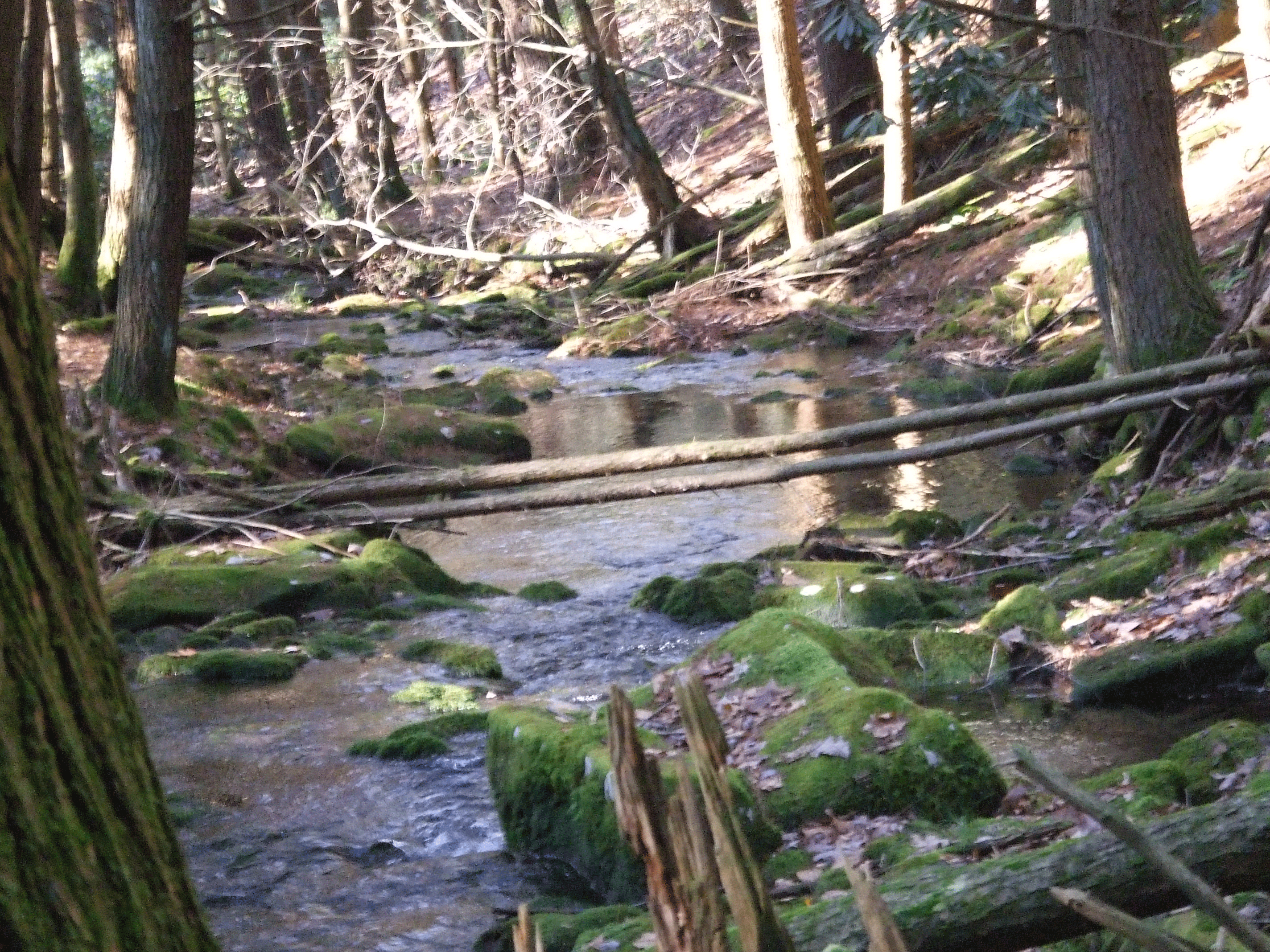
The Spring Run Hemlock Biological Diversity area is in one of the plots that will be documented as part of the Lock Haven forest inventory. The run is part of the water supply for the city. (Photo: Ann Murray)
MURRAY: The Conservancy hopes to expand Working Woodlands to other Appalachian states and is currently in China in Szechwan Province. There’s a temporal forest there that looks a lot like the Appalachian woods.
For Living On Earth, I’m Ann Murray in Lock Haven, Pennsylvania.
CURWOOD: Our story on forests comes to us by way of the Pennsylvania public radio program, The Allegheny Front.
Related links:
- More about the working woodlands program of the Nature Conservancy in Pennsylvania
- The Allegheny Front Radio Show
[MUSIC: Bill Frisell “Give Me A Holler” from Nashville (Nonesuch Records 1997)]
How Insects Influence Plant Evolution
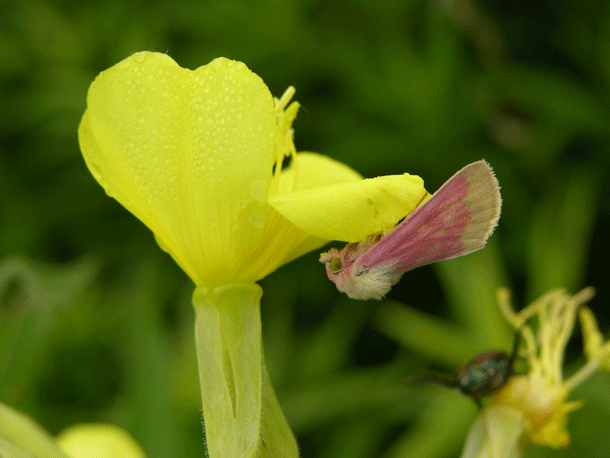
Schinia florida on an evening primrose flower with morning dew. (Photo: Anurag Agrawal)
CURWOOD: Well - for the silk we use, we depend on the mulberry tree that feeds the silk-worm.
And for millenia, insects - such as the silk worm – have in turn helped guide the evolution and defenses of plants.
A new 5 year study from researchers at Cornell University in Science Magazine focuses on the critical role insects can play in plant evolution, and how speedy that evolution can be.
The lead author is Anurag Agrawal, Professor of Ecology and Evolutionary Biology at Cornell.
AGRAWAL: Essentially plants are the only group of organisms on the planet that can generate their own energy. And something that we don’t often think about is the entire biosphere - all organisms in the food chain - are either directly or indirectly dependent upon plants.
We don’t think of lions as being dependent upon plants, or a particular bird species, but they eat organisms which eat other organisms which fundamentally must rely on plants - eat plants to get their energy. And, because of that, there’s been tremendous natural selection, tremendous pressure on plants over the eons to develop defenses.
CURWOOD: Talk to me about the way that plants have evolved alongside insects.
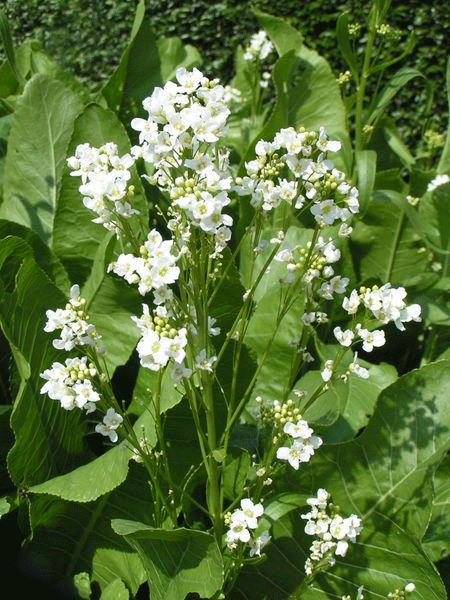
Horseradish plant (Wikimedia Creative Commons)
AGRAWAL: Yeah, there’s been a long history of circumstantial evidence that many of the traits plants have are adaptations to insect herbivores. If you think about the things we eat, what makes horseradish spicy? Horseradish is spicy because of a series of compounds called glucosinolates that we believe have evolved by natural selection to ward off insects. You know, the poisons that make milkweed so famous? - you know, same expectation. What’s nicotine? Nicotine is a neurotoxin of tobacco that has evolved by natural selection to ward off insects.
CURWOOD: Please describe the specifics of your study for us – what were you looking at?
AGRAWAL: Well, what we did is we set out experimental plots here at Ithaca, New York to examine the impact insect herbivores have on the plants, and removed insects from half of the plots using an insecticide treatment, and over a very quick period of time – about five years, five generations of the plants we were studying, the common Evening Primrose, it’s a wildflower – removal of insects resulted in the evolution of two very critical plant traits: How early the plants flower and the production of a toxin in the fruits of those flowers. When we removed insects, the plants were able to relax those defenses. They flowered earlier and they produced less of those toxins in their fruits.
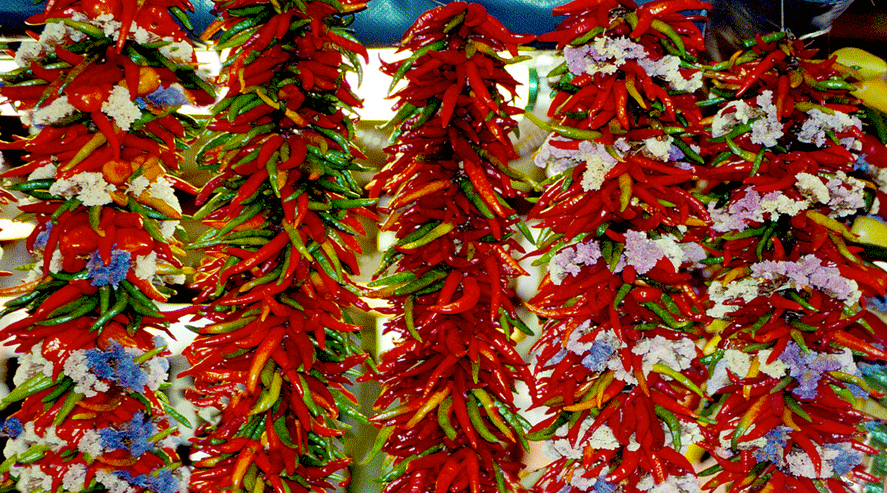
Hot peppers drying in a market. (Photo: Donna Sutton)
CURWOOD: So how surprised were you by these results?
AGRAWAL: The results that we got we had anticipated, and it was sort of part of our hypothesis, but what really surprised us was the rapidity of this evolutionary response. Seeing this response in five years was dramatic and it sort of – you know, it really knocked our socks off in the sense that, we know that evolution can be rapid, but to watch it happen, watch the genetic change happen over that period of time, was something that surprised us and the rest of the scientific community.
CURWOOD: I mean, one thinks of evolution, one thinks that it takes a long time for example, say to get from the great apes to humans - like millions of years, right?
AGRAWAL: Yeah, and that’s right. Evolutionary biology, in a sense is a historical science. We’re trying to piece together, often, how we got to where we are now, by looking into the past. And you’re certainly right that most speciation events – that is when one ancestor gives rise to two new entities that are isolated reproductively –often does take thousands to millions of years.
In our study, what we’re talking about is the rapid adaption that occurs within a species, and the way one might think about how this might be operative in nature is as the climate changes, as we have a set of good or bad years, if in a particular location there are high pest loads compared to another place where there are low pest loads, we can expect to see rapid change in those populations.
If those environmental effects are sustained over hundreds or thousands of years, we might then expect a new species to be born.
CURWOOD: So, seeing such rapid evolution in plants, what do you see as the larger significance of these findings?
AGRAWAL: I think there are a few things that are significant. One is the recognition that evolution occurs all around us. I think that’s an important message for the American public, in the sense that there’s surprising to me and many scientists still some debate about the importance of evolution in the history of the planet and the history of the organisms that we have on the planet. So, the fact that we can in real time, see that change in genes and genotype frequencies in that short period of time is a critical message to the public.
From a biological, and more academic perspective, one of the things we reported, one of the things that I think was known to Darwin, and that he sort of speculated on but still hasn’t cemented itself as dogma among scientists, and that is that – on the same time scale that ecological interactions occur, in our study for example, as the environment changed, - competition between species, plants that were in our plots, was intensified. On that same time scale, there were evolutionary changes that were occurring. And so I think one of the main messages to the academic community is: ecology or environmental change, and evolution, can occur on the same time scale and may in fact feed back with one another.
CURWOOD: I must ask what are the implications of your study and how we think about insecticides?
AGRAWAL: Well, it’s complicated, and I appreciate the question. Insecticides certainly have been a very valuable tool in the production of agricultural crops, and I think that what it tells us is that when we take insects out of the picture – using things like insecticides – we are encouraging plants throughout the evolutionary process to relax their defenses.
And, in fact, this is a story that I think is unfortunately really a big part of worldwide agriculture, and that is that we tend to select varieties of plants to grow that are diminished in their natural defensive capacities. If you take a wild plant that has survived out there for millions of years, it typically has a remarkable array of toxins and defense tactics to ward off pests.
About 10 percent of all plants produce hydrogen cyanide. We know hydrogen cyanide as a very general toxin – an anti-life compound – and it’s hydrogen cyanide that’s in 10 percent of the plants. It has no primary function, it doesn’t help the plant capture sunlight or produce seeds directly, what hydrogen cyanide does is it poisons insects that are trying to eat those plants.
One of the things that I think we do a little too well is we – either on purpose or inadvertently – we breed crops so that they have relaxed defenses and that increases our needs and our usage of pesticides, which I think we can all agree is problematic for the environment.
CURWOOD: Anurag Agrawal is Professor of Ecology and Evolutionary Biology at Cornell University. Thanks so much for taking the time today!
AGRAWAL: Thank you!
Related link:
Abstract of paper on insect-driven evolution in Science Magazine
[MUSIC: Squirrel Nut Zippers “Bedbugs” from The Best Of The Squirrel Nut Zippers (Mammoth Records 2002)]
Snow in Summer
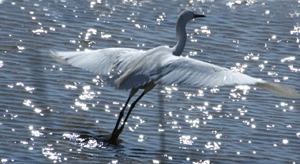
The Snowy Egret (Photo: © Salt Marsh Diary)
CURWOOD: Animals can use patterns and colors as camouflage…zebras and tigers have their stripes…hyenas and leopards their spots…but as writer Mark Seth Lender observes… the white Snowy Egret stands out in a crowd.
LENDER: The Snowy Egret lands, the name and color of a substance she will never see. There on the muddy bank, still as chalk her carved and ancient figure stands stilting. Like Nike, she leaps sailing into the bright, wide-winged above the shallow water where she feeds, so white sunlight seems shadow.
What could be the purpose of such brilliance, Snow in Summer? Perhaps in some prior life this most strident, most absolute of colors kept her safe in a far and frigid land, and all these amazing feathers are only an artifact of dim ice ages past. Or in the brief season between her comings and goings this is her temporary color, as polished and transparent as paper made of rice, except there is no other phase than white when Egret flies.
There is fragility in all this. The bird, the salt marsh where she lands, even the turbulent sand. From the South the assault comes by hurricane, each season earlier and more ferocious than the last. From the North it is the melting, and where there is no flood, drought. There is no reprieve. As the brackish plain is silted out or altogether gives way, where will Snowy Egret go? How will she retreat from Winter when Winter itself is in retreat?
When the sun pounds like the hammer to the anvil all life is forged to the blow. The upper latitudes break away. The equator burns. North and north and north the southern creatures go driven there by unfamiliar weathers. Life once rare becomes common. The common vanishes. Perhaps it is not camouflage but survival of a more intense and personal kind which turns the egret white, reflecting not just light, but heat. Maybe she will be all right. What about us, I wonder.
CURWOOD: Mark Seth Lender’s new book is called “Salt Marsh Diary: A Year on the Connecticut Coast.” To see some of his photographs and find out more about his writings, go to our website at LOE.org.
[MUSIC: Goldfish “Snow” from Coming Home (Pale Music 2007)]
CURWOOD: Coming up..listening to the dawn chorus as naturalist Aldo Leopold heard it more than 70 years ago - Stay tuned to Living on Earth!
ANNOUNCER: Funding for Living on Earth comes from the Grantham Foundation for the protection of the environment. Supporting strategic communications and collaboration in solving the world’s most pressing environmental problems. The Kendeda Fund, furthering the values that contribute to a healthy planet, and Gilman Ordway for coverage of conservation and environmental change. This is PRI, Public Radio International.
[CUTAWAY MUSIC: Pat Metheny: “Every Summer Night” from Letter From Home (Geffen Records 1989)]
Fungi
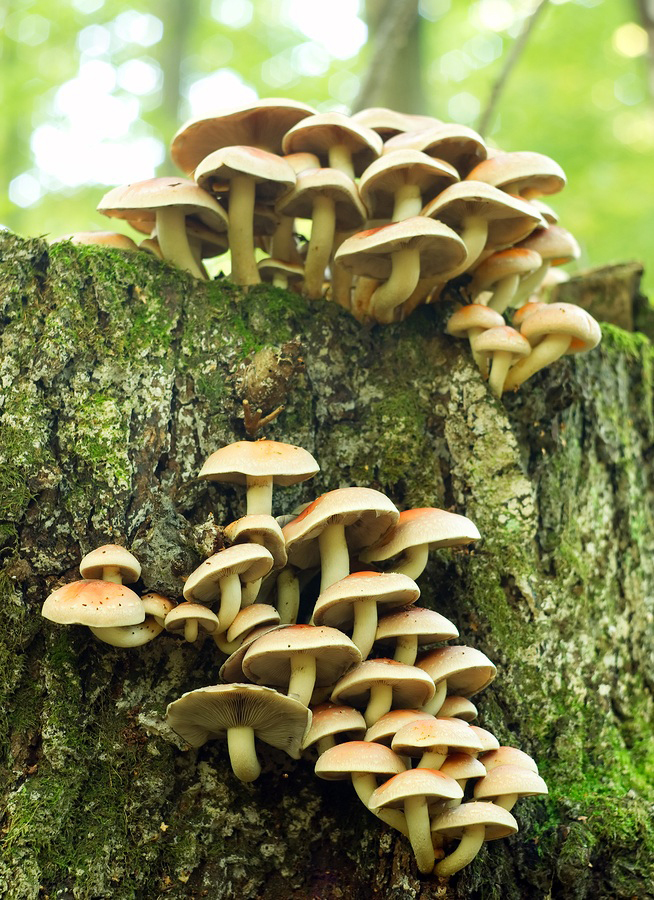
Sulphur Tuft fungus. (Bigstockphoto.com)
CURWOOD: It's Living On Earth, I'm Steve Curwood. Now think of bacteria - and people often want to reach for the anti-microbial spray and clean the place up. But the increasing understanding of the vital role played by the microbiome in ourselves and in the world around us is winning these tiny critters some new respect. And that'd likely be just fine for the subject of our next story. From the Encyclopedia of life special series, One Species at a Time - here's Ari Daniel Shapiro.
CURWOOD: Hamlet, that deep thinker, told his friend Horatio that there were more things in heaven and earth than were dreamed of in his philosophy. Well, Ari Daniel Shapiro has been bringing us regular insights into the myriad diverse species to be found in the living world. And today, he brings us a kingdom - and a riddle.
SHAPIRO: I’m pretty sure you haven’t heard this one before. What is all around us and very hard to see, and both dismantles and shapes our world??
BODDY: Let’s have a little look for another log.
SHAPIRO: Lynne Boddy – an ecologist from Cardiff University in Wales – is the one who gave me the idea for the riddle.
[RUSTLING SOUNDS]
SHAPIRO: She’s shuffling through the leaves in a little patch of forest in Concord, Massachusetts.
BODDY: Oh, look at this.?
SHAPIRO: She’s spotted a soft birch tree log lying on the forest floor. Boddy kneels down and starts tugging on the log.
BODDY: We’ve turned over this log. Can you see this?
SHAPIRO: Oh, yeah! A few limp, cream?colored threads descend from the rotting log and make their way into the soil. They look like plant roots to me. But I’m wrong.
BODDY: What we’re looking at is the main part of a fungus. Most of us think of fungi as things like mushrooms and toadstools. But that’s just the tip of the iceberg. That’s the fruit body, and the fruit bodies are like the flowers of flowering plants. There’s another part of the fungus – it’s usually hidden in rotten wood and in the leaf litter on the forest floor.
SHAPIRO: They’re really helping to kind of connect this rotting wood to the soil.
BODDY: That’s exactly right. They are.
SHAPIRO: These fungal threads – or mycelia – are doing the work of decomposition, slowly digesting and feeding upon this birch tree. One example is the sulphur tuft fungus.
BODDY: Hypholoma fasciculare.
SHAPIRO: An organism that grows both in the US and in Britain. Boddy gingerly holds its mycelium and begins tracing it through the soil.
BODDY: Oh my goodness! It’s attached to an acorn from this oak tree. So it’s not only decomposing the wood of the birch tree, but it’s decomposing this old acorn.
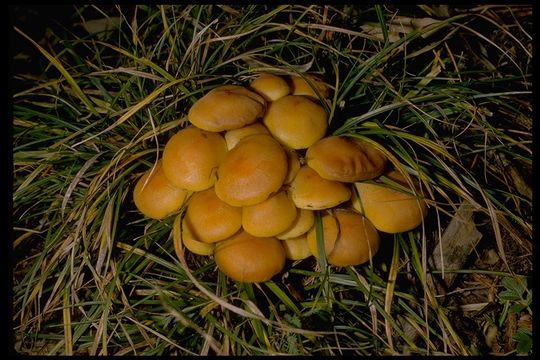
Sulphur Tuft fungus. (The Encyclopedia of Life)
SHAPIRO: A little farther along, the fungal threads have grabbed a hold of another little acorn hat, crawled along its perimeter, and surged out the other end in search of something else to colonize – a branch, a tree stump, or another log. Nutrients consumed in one part of the fungi get routed into this vast, interconnected mycelial network. And if one part of the network gets chewed up by a wood louse, say, or stomped through by a deer, it’s no big deal for the fungus. It’s so interconnected that there’s little risk of chopping one of these fungi in two.
Boddy loses the trail when the mycelia plunge straight down into the soil. But this fungal tapestry doesn’t just carpet the forest floor.
BODDY: In all of these trees that you see around us, there are fungi within the trunks and branches, not doing very much – just tiny, tiny, little pockets. And then the minute that the water in the sapwood of these trees stops flowing, these fungi will grow into bigger mycelia and start the decay process. So the minute this tree comes down, or even before, decay has started. Then spores will land, and they will try to get in, and it will have landed on a network of cords on the forest floor. And that fungus will get in too. And so we have a battle going on in this wood.

Sulphur Tuft fungus. (The Encyclopedia of Life)
SHAPIRO: A greedy battle over the nutrients locked up inside the newly dead tree. So that’s one portrait of the fungal community – lying in wait, wood?thirsty, and skirmish? prone. But there’s another side to fungi. The benevolent side, and the second half of the riddle – what not only dismantles, but also shapes our world.
BODDY: None of these plants in this beautiful woodland would be here if it were not for fungi for two very good reasons. One is that the fungi, which are decomposing, actually release the nutrients that are locked up. Those nutrients can then be used by the trees around. And the second reason is that all of these plants, every single one of these plants around us have fungi attached to their roots.
SHAPIRO: These mycorrhizal fungi – species like Amanita brunnescens here in this woodland – associate with 90% of the plants on Earth. They ensheath the roots. Or sometimes they grow in between root cells. These fungi absorb water and nutrients from the soil, and share them with the plant. In exchange, the fungi get some of the sugars pulsing through the plant roots.
BODDY: It’s plants plus fungi that make the ecosystems of our planet work.
SHAPIRO: Plants are, I mean, I think of them as independent beings, you know, they just need the sun in order to survive, but you’re saying that they wouldn’t stand one minute without fungi.
BODDY: That’s absolutely true.
SHAPIRO: In fact, Boddy says that plants needed fungi to be able to colonize land 450 million years ago. So fungi both nourish and destroy. They pump vital fluids rich with nutrients into the very ecosystems that other fungi will later carve up and consume. They digest the dead, leaving behind the raw materials for new life to be born. And it just takes getting your hands a little dirty to trace the weave of their vast network.
BODDY: Ok, look here! Now, oh, that’s interesting, isn’t it?
[RUSTLING THROUGH LEAF LITTER]
SHAPIRO: For Living on Earth, I’m Ari Daniel Shapiro.
CURWOOD: Our story on fungi is part of the series, One Species at a Time, produced by Atlantic Public Media, with help from the Encyclopedia of Life.
Related link:
One Species at a Time
[MUSIC: Tony Monaco “Fungi Mama” from Burnin Grooves (Summit Records 2002)]
Sounds Heard by Aldo Leopold

Aldo Leopold and his dog. (Forest History Society)
CURWOOD: In the early morning before dawn, Aldo Leopold would sit on a bench outside his shack in Sauk County, Wisconsin, with a pot of coffee and a notebook. As the sun rose, he took detailed notes as each bird joined the dawn chorus. Aldo Leopold was well known for his observations of the natural world, gathered in his 1949 book A Sand County Almanac, that many consider to be some of the finest essays on the intrinsic value of nature. Well, now we can actually hear the chorus that Aldo Leopold made note of in his morning journal, thanks to a team led by Stanley Temple, Professor Emeritus in Conservation at the University of Wisconsin-Madison.
Professor Temple joins us from Madison. Welcome to Living on Earth!
TEMPLE: Glad to be here!
CURWOOD: So, Aldo Leopold is an iconic figure to some, but for those of us who aren't as familiar with his work, who was Aldo Leopold?
TEMPLE: Aldo Leopold was probably the most influential conservation thinker of the 20th century. His career spans the first half of the 20th century and during that time he made some remarkable contributions. He began his career as a forester, but by mid-career he turned his attention to broader issues of conservation. And for most people, what they know best about Aldo Leopold, was that he left us A Sand County Almanac. This was, essentially, the culmination of his life journey and it expressed his ideas about our relationship with the natural world.
CURWOOD: Professor Temple, you're a scientist by training, so how did you become so interested in this historical figure?
TEMPLE: Well, I was fortunate during my 32 years as a faculty member at the University of Wisconsin to have occupied the chair that Aldo Leopold once held. Not only was he a hero of mine personally, but because of my professional ties to him I made it my business to learn more about him. And the University's archives has just a remarkable collection of his papers. And among those papers I discovered an unpublished manuscript that he was working on at the time of his death in which he described the work that he had done over a decade of time studying the dawn chorus of birds, and in particular, how the sequence of songs plays out in the early morning light.
CURWOOD: What scientific observations did Aldo Leopold make about the morning bird chorus?
TEMPLE: He became fascinated with the sequence in which birds joined the dawn chorus and he was working on a hypothesis that the sequence was determined by light intensity. That each bird joined in the chorus, cued, you might say, by the intensity of the light. He bought one of the earliest light meters that were available, something that measured light intensity. He was very early in sort of posing this hypothesis. Others in the 1950s when the technology was better followed up and indeed, verified that Leopold's ideas were correct.
CURWOOD: Please describe for us Aldo Leopold's dawn birding routine.
TEMPLE: Well, we could actually use his own words because he does describe it in nice detail in one of his essays in A Sand County Almanac called "Great Possessions:"
"My daily ceremony, contrary to what you might suppose, begins with the utmost decorum. At 3:30 am, with such dignity as I can muster, I step from my cabin door bearing in either hand a pot of coffee and a notebook. I get out my watch, pour coffee, and lay notebook on knee. This is the cue for the proclamations to begin."
CURWOOD: What gave you the idea to try and recreate the sounds that Aldo Leopold heard in his shack in Wisconsin?
TEMPLE: Well, having read the unpublished manuscript, it struck me that you could put together from his notes all of the ingredients that would be required to recreate the sound that he was hearing. Well, it lay on the shelf or in the filing cabinet for many many years and this past summer Brian Pijanowski, who's one of the leaders in the new soundscape ecology movement, invited me to give the keynote address at an NSF workshop that was held at the Leopold Center here in Wisconsin. And I thought this was the perfect incentive to actually go back and see whether indeed we could recreate the soundscape Leopold was listening to from his notes.
CURWOOD: What was your process?
TEMPLE: Well, the process was first, of course, was to go through all of Leopold's notes and develop what you might say is a score. And then I enlisted the help of Chris Bocast, a graduate student here at the University of Wisconsin campus who is an excellent audio engineer. And with the help of the Cornell Lab of Ornithology providing the actual recordings of the bird songs, we were able to put together a facsimile of what Aldo Leopold was listening to back on June 1, 1940.
CURWOOD: I'm wondering what kinds of materials you were working with here; what did Aldo Leopold's notes look like?
TEMPLE: His notes were taken in a shorthand and what he noted was the time at which he first heard each bird joining the chorus. And he then took notes on how frequently he heard each species singing. So with that information, we could actually put the birds into the proper sequence and the proper timing of their calls but it went further than that. If you listen to the tape that we produced, in stereo, we've actually placed the birds in the soundscape in the relative positions that they should be in based on Aldo Leopold's territory maps. So the birds that appear to be coming from the left are birds of the field and prairie. The birds that are coming from the right are birds associated with the woodland and the birds in the middle are the ones associated with the edge in between the field and the woods.
CURWOOD: We’re going to play a clip from your soundscape now. Please, identify some of the sounds for us as we listen.
[SFX: ROBIN SINGING]
TEMPLE: Starts off with the American robin, an early riser.
[BIRD CALLS UNDER THE DISCUSSION]
TEMPLE: You can hear some birds in the distant background but the next bird to join is a field sparrow.
CURWOOD: That trill is the field sparrow?
TEMPLE: That's the field sparrow. We paid attention to the birds that were very close to Leopold, the ones that he said he paid attention to. The next bird you're going to hear is an indigo bunting. You can hear crows in the background.
CURWOOD: Good thing they were in the distance - they can be pretty loud!
TEMPLE: Yeah.
CURWOOD: Now is this a compression of time or is this in real time here?
TEMPLE: We did compress the time; we didn't compress the bird songs. What we did was compress the intervals between each bird's calls, but we compressed them proportional to Leopold's notes. So we actually compressed the first half hour of the day into five minutes. It still sounds pretty much like what it really does sound like. Not quite so much down time between calls.
CURWOOD: Now who else has joined in here?
TEMPLE: The wood pewee comes in followed by the song sparrow and gray catbird. They start to pile on pretty quickly about this point.
CURWOOD: Okay, who's that?
TEMPLE: That's a catbird, sounding like a cat mewing.
CURWOOD: So what does the land around Aldo Leopold's shack look like today?
TEMPLE: Well, it's undergone quite a transformation since 1935 when Aldo Leopold purchased this worn-out farm that had almost no vegetation on it to speak of. He and his family spent many thousands of hours planting prairies, planting trees, and today, of course, what you see is a fairly mature ecosystem and because of that the birds you hear today are a slightly different blend of birds, mix of birds, than Leopold was listening to. There are certainly more species in the dawn chorus today than there were in Leopold's time because of the habitat that Leopold and his family created for them.
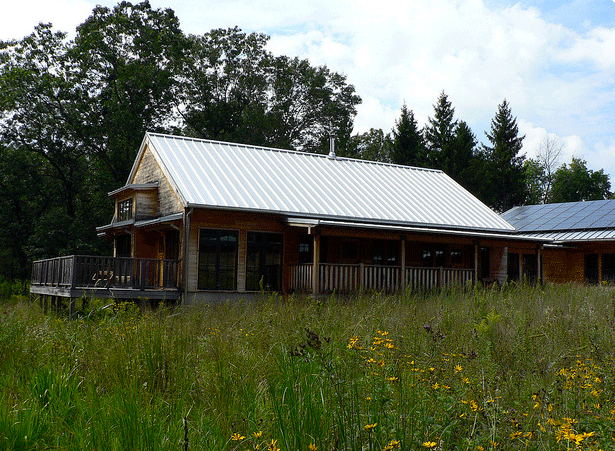
The Aldo Leopold Center (Rebecca Brown)
CURWOOD: So we're going to play a clip now of the dawn sounds around the cabin taken from this summer. Let's have a listen.
[SFX: BIRD SONGS AND DISTANT TRAFFIC SOUNDS]
CURWOOD: Well, there are a lot more birds there but it's pretty hard for me to hear them.
TEMPLE: That's right. But what you do hear is the traffic from the interstate.
CURWOOD: How do you think Aldo Leopold would respond if he could hear the morning soundscape that you recorded in 2012?
TEMPLE: Well, I think Leopold already gives us a hint that he was, to some extent, offended by the sounds of humanity that were impinging on the natural sounds. I'm going to read just a couple of sentences from another of his essays from A Sand County Almanac called "Too Early," in which he talks about arriving very early in a duck blind in a marsh.
"To arrive early in the marsh is an adventure in pure listening. The ear roams at will among the noises of the night without let or hindrance from hand or eye. Like many another treaty of restraint, the pre-dawn pact lasts only as long as darkness humbles the arrogant. By breakfast time comes the honks, horns, shouts, and whistles of an awakening farmyard and finally, at evening, the drone of an unattended radio."
So Leopold was well aware that the sounds of human beings were intruding on natural sounds. So I don't think he'd be surprised. I think he might have been offended by the fact that the interstate highway came so close to his beloved shack.
CURWOOD: What's your favorite passage from A Sand County Almanac that you would feel comfortable reading right now that captures Aldo Leopold's thoughts on nature?
TEMPLE: Well, I think it's one that many people who are conservationists are aware of. It's one that gets quoted fairly often:
"If the land mechanism as a whole is good, then every part of it is good, whether we understand it or not. If the biota in the course of eons has built something we like but do not understand, then who but a fool would discard seemingly useless parts? To keep every cog and wheel is the first precaution of intelligent tinkering."
I think you could apply that golden rule of Aldo Leopold's to the problems of soundscapes being polluted, if you will, by human-generated noises.
CURWOOD: Stanley Temple is a Professor Emeritus at the University of Wisconsin and a senior fellow at the Aldo Leopold Foundation. Thank you, sir.
TEMPLE: You're very welcome.
Related link:
Sounds heard by Aldo Leopold
[MUSIC: Joe Sample “Paintings” from Carmel (UMG Records 1979)]
CURWOOD: Living on Earth is produced by the World Media Foundation. Naomi Arenberg, Bobby Bascomb, Emmett Fitzgerald, Helen Palmer, Poncie Rutsch, Erin Weeks, Adelaide Chen, James Curwood, Jennifer Marquis and Gabriela Romanow all help to make our show. Jeff Turton is our technical director. Alison Lirish Dean composed our themes. You can find us anytime at LOE.org, and check out our Facebook page, it’s PRI’s Living on Earth. And we tweet from @LivingOnEarth. I'm Steve Curwood. Thanks for listening.
ANNOUNCER 1: Funding for Living on Earth comes from the Grantham Foundation for the protection of the environment. Supporting strategic communications and collaboration in solving the world’s most pressing environmental problems. The Kendeda Fund, furthering the values that contribute to a healthy planet, and Gilman Ordway for coverage of conservation and environmental change. Living on Earth is also supported by a friend of The Nation, where you can read such environmental writers as Ren Stevenson, Bill McKibben, Mark Hertsgaard and others at TheNation.com. This is PRI, Public Radio International.
ANNOUNCER 2: PRI, Public Radio International.
Living on Earth wants to hear from you!
Living on Earth
62 Calef Highway, Suite 212
Lee, NH 03861
Telephone: 617-287-4121
E-mail: comments@loe.org
Newsletter [Click here]
Donate to Living on Earth!
Living on Earth is an independent media program and relies entirely on contributions from listeners and institutions supporting public service. Please donate now to preserve an independent environmental voice.
NewsletterLiving on Earth offers a weekly delivery of the show's rundown to your mailbox. Sign up for our newsletter today!
 Sailors For The Sea: Be the change you want to sea.
Sailors For The Sea: Be the change you want to sea.
 The Grantham Foundation for the Protection of the Environment: Committed to protecting and improving the health of the global environment.
The Grantham Foundation for the Protection of the Environment: Committed to protecting and improving the health of the global environment.
 Contribute to Living on Earth and receive, as our gift to you, an archival print of one of Mark Seth Lender's extraordinary wildlife photographs. Follow the link to see Mark's current collection of photographs.
Contribute to Living on Earth and receive, as our gift to you, an archival print of one of Mark Seth Lender's extraordinary wildlife photographs. Follow the link to see Mark's current collection of photographs.
 Buy a signed copy of Mark Seth Lender's book Smeagull the Seagull & support Living on Earth
Buy a signed copy of Mark Seth Lender's book Smeagull the Seagull & support Living on Earth

